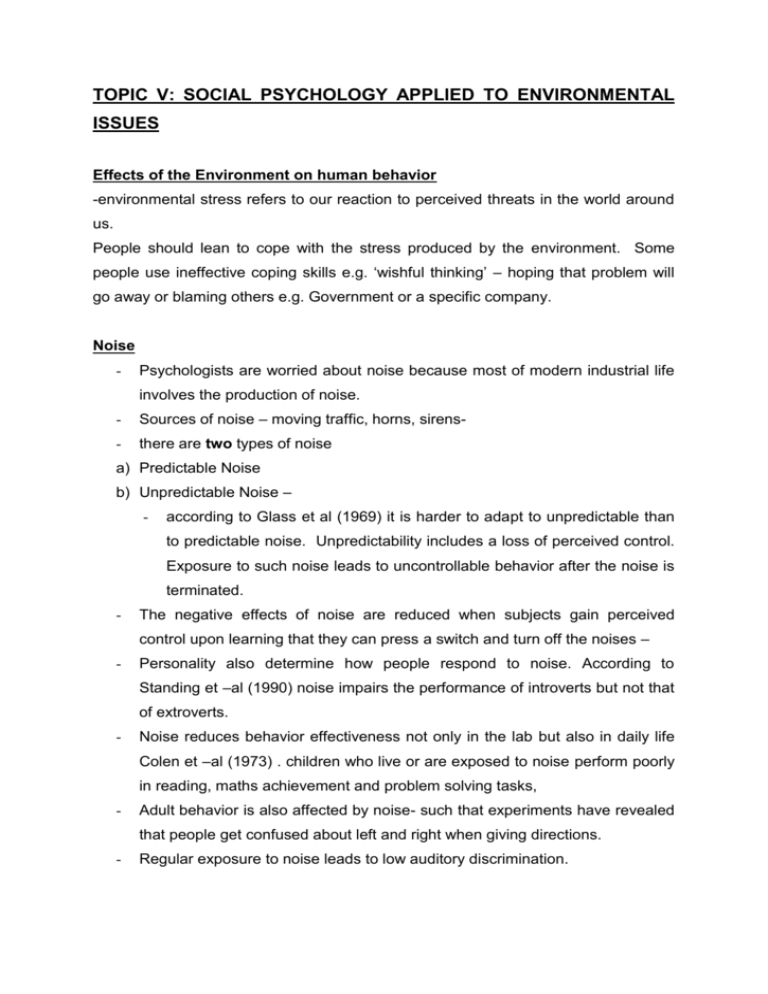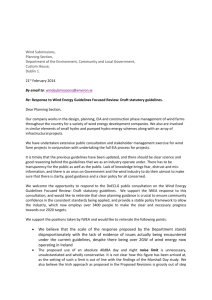topic v: social psychology applied to environmental issues
advertisement

TOPIC V: SOCIAL PSYCHOLOGY APPLIED TO ENVIRONMENTAL ISSUES Effects of the Environment on human behavior -environmental stress refers to our reaction to perceived threats in the world around us. People should lean to cope with the stress produced by the environment. Some people use ineffective coping skills e.g. ‘wishful thinking’ – hoping that problem will go away or blaming others e.g. Government or a specific company. Noise - Psychologists are worried about noise because most of modern industrial life involves the production of noise. - Sources of noise – moving traffic, horns, sirens- - there are two types of noise a) Predictable Noise b) Unpredictable Noise – - according to Glass et al (1969) it is harder to adapt to unpredictable than to predictable noise. Unpredictability includes a loss of perceived control. Exposure to such noise leads to uncontrollable behavior after the noise is terminated. - The negative effects of noise are reduced when subjects gain perceived control upon learning that they can press a switch and turn off the noises – - Personality also determine how people respond to noise. According to Standing et –al (1990) noise impairs the performance of introverts but not that of extroverts. - Noise reduces behavior effectiveness not only in the lab but also in daily life Colen et –al (1973) . children who live or are exposed to noise perform poorly in reading, maths achievement and problem solving tasks, - Adult behavior is also affected by noise- such that experiments have revealed that people get confused about left and right when giving directions. - Regular exposure to noise leads to low auditory discrimination. Short term noise- people may be exposed to short term- noise. Initial reaction is usually the startle reflex- jump, flex stomach muscles etc. even when noise is expected people respond physiologically- high BP and sweating. However people adapt quickly to short term noise. Long term Noise- e.g. those who live in lower floors in city centers- these are always noisier than higher floors. Studies have shown that children living in lower floors had poor auditory and reading skills. White noise – soothing that helps you to relax (how can social psychological principles be used to reduce noise) Temperature and Behavior - According to Kennick and Macfarlone (1986) the higher the temperature – the more drivers sounded their horns at a car that failed to move when the lights turned green - Anderson and Anderson examined the association between the number of aggressive crimes (murder and rape) and daily temperature over a two year period in two large American Cities. Data indicated that criminal violence occurred more frequently as the temperature rose. However relationship between temperature and non violent crimes was much weaker. According to the Negative Affect Escape Model by Baron and Bell (1976) as the heat increased to a certain point aggression begins to decline. Air Pollution Human activities have led to the pollution of the air. People however fail to notice the effects once they have stayed in a polluted atmosphere/ environment - Air that smells bad elicits negative feelings and less friendly interpersonal behavior – good air leads to positive emotions and friendly behavior. - Addition of pleasant smells to a work setting could enhance morale and performance - Cigarette smoke- smokers face serious health risk- also non smokers who breath smoke filled air are more likely to develop health related problems these are called passive smokes e.g. non smoking women married to heavy smoking man are more likely to develop lung cancer than similar women whose husbands do not smoke - Children exposed to 2nd hand smoke usually develop respiratory illness (Kenworthy) (1993). Effect of Human Behavior on the Environment - Most of human behavior has an effect on the environment e.g. driving a car, using hair spray, buying a plastic bag etc. - However the effects are neither obvious nor immediate. The Green house Effect - Global Warming- is a situation whereby the earth becomes warmer than usual and this is exacerbated by human behavior. Effects of global warming include melting of ice caps- seas will rise and many areas will be covered by H2O (Schneider, 1989) - Global warming is caused by green house effect: The trapping of heat by rising levels of the following 3 gases in the earth’s atmosphere . - CO2 contributes to 50% of global warming -when people began to use coal as fuel CO2 production increased. - Deforestation – has led to fewer trees to absorb CO2. - Methane and Chlorofluorocarbons contribute 25% each. Methane is generated in rice paddies and forest fires. - CFCs are used in refrigerators; air conditioning and many sprays. CFC in addition to trapping heat in the atmosphere also creates holes in the ozone layer. - To reduce CO2 emmissions there is need to develop technology that is free from burning organic matter. People should use public rather than private transport, plant new trees –( each tree absorbs about 48 pounds of CO2 annually), Grondahl (1989). CFCs must be banned completely and replaced with alternatives. (2) Garbage, litter and other waste products - As human population grows – more and more waste products are produced. - People need to be motivated to avoid littering that is throwing rubbish in inappropriate places e.g. sidewalks. Durdan et al (1985) compared the effects of negative and positive messages (prompts) on cafeteria littering. Positive prompts “please be helpful” resulted in less littering than mildly negative prompts “please don’t litter” - Before prompts over ½ of the students littered, when prompts were present, fewer than a 1/3 littered. - Clark et al (1972) provided rewards to reduce littering in theaters. People were given liter bags and when these were filled and turned in customers received a free movie ticket. Litter was reduced by 10%. Recycling -An effective legislative approach to motivating people to recycle uses a combination of mild coercion and a small monetary reward. -In Canada and USA – customers who purchase beer and soft drinks and other liquids in bottles and cans must pay a small deposit included in the price for each item. The reward is the refund of the deposit when the customer returns the can to the store even when cans are thrown people pick them to get the money. -Kahle & Beatty (1981) Found out that when a bottle bill is enacted into law, recycling behavior changed despite feelings of reluctance. This new behavior becomes habitual, and then altitudes change to correspond to the altered behavior (cognitive dissonance) there is also changes in subjective norms about what is the right thing to do- once these behaviors and attitudes change there is also an interesting generalization to other environmental concerns and to other pro- environmental actions. Legislation leads to reluctant behavioral compliance Attitude shift reduce cognitive dissonance Legislation regulates one aspect compliance with law is based on monetary environmental behavior change rewards and acceptance of social norms (The bottle bill legislation) New behavior becomes habitual Attitudes are generalized, resulting in positive views about environment issues attitudes towards the bottle bill become more favorable – a shift based on desire for Consistency Environmental risk perception Risk communication and assessment Using the behavioral approach to solve environmental problems







